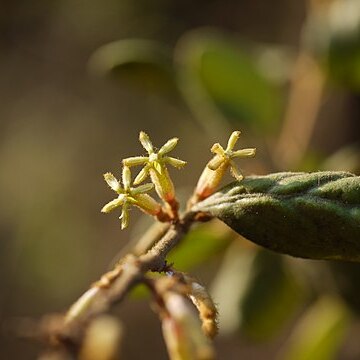Shrubs parasitic, most young parts usually with dense stellate and/or verticillate hairs, rarely glabrous (in T. delavayi). Leaves opposite or alternate, pinnately veined. Inflorescences axillary, umbels or rarely short, irregular racemes, 2-5-flowered; 1 bract subtending each flower, usually scale-like. Flowers bisexual, 4[or 5]-merous, zygomorphic. Calyx ellipsoid or ovoid, rarely subglobose, base not attenuate, limb annular, entire or denticulate, persistent. Mature flower bud tubular, tip ellipsoid or ovoid. Corolla sympetalous, slightly curved, basal portion ± inflated, split along 1 side at anthesis, lobes all reflexed toward the side away from the split. Stamens inserted at base of corolla lobes; filaments short to almost absent; anthers 4-loculed, sometimes multilocellate. Pollen grain trilobate or semilobate in polar view. Ovary 1-loculed; placentation basal. Style filiform, 4-or 5-angled; stigma usually capitate. Berry ellipsoid or ovoid, rarely globose, exocarp leathery, verrucose or granular, rarely smooth, pubescent or glabrous, base rounded.
Aerial stem-parasitic shrubs, more or less clothed in a tomentum of stellate hairs, slender to moderately robust, with epicortical runners bearing secondary haustoria. Leaves opposite. Inflorescence a simple few-flowered umbel; bract single under each flower, simple. Corolla 4-or 5-merous, gamopetalous, zygomorphic, with the tube curved prior to anthesis, deeply split on the inner side of the curve; lobes reflexed to the outer side at anthesis. Anthers basifixed, immobile. Style simple, with a knob-like stigma. Fruit ellipsoid. Fig. 43.

